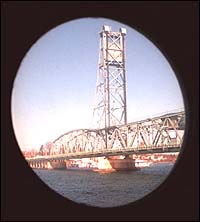 PORTSMOUTH, N.H. :
PORTSMOUTH, N.H. :
Peering through the porthole at the restaurant in the former tugboat John Wanamaker.
|
Portsmouth, N.H.
Houses of history
By Jan Shepherd
 or a community of about 25,000 people, New Hampshire's second oldest town certainly has a slew of diversions. An easy way to focus a day trip is to pick a theme such as history, food, art, or the sea. Even then, you won't be able to do it all in a day. On a recent Saturday, I crammed history, food, and art into seven hours. or a community of about 25,000 people, New Hampshire's second oldest town certainly has a slew of diversions. An easy way to focus a day trip is to pick a theme such as history, food, art, or the sea. Even then, you won't be able to do it all in a day. On a recent Saturday, I crammed history, food, and art into seven hours.
Strawbery Banke Museum is probably the best known historic site here. The museum is the story of a neighborhood and its residents whose fortunes ebbed and flowed over three centuries until hard times made it a less-than-desirable place to live after World War II.
Luckily, activists stopped the urban renewal bulldozers from leveling the old to make room for the new. Marking its 40th anniversary this year, the museum spurred other restorations that now make Portsmouth, founded in 1623 and incorporated in 1631, so appealing.
The museum is not a re-created theme village, but a 10-acre ''neighborhood'' of 30 buildings with 10 furnished houses representing different eras, period gardens, shops, six exhibit buildings, and others awaiting restoration. It's a self-guided tour, so you set your own pace. Each site has its own story.
Abbott's Store, reflecting 1943-46, is the story of Walter and Bertha Abbott who bought the small shop in 1919. After he died, she ran it with the help of a high school lad, Leslie Clough. When the museum was restoring the store to the war era, Clough was the adviser, detailing what items the store sold and where they were shelved. People who used to live here walk into the store and think time stood still, says Mark J. Sammons, director of research.
Getting there:
From Boston, take Interstate 95 northbound to Exit 7 Market Street/Historic Sites, last of four Portsmouth exits and last New Hampshire exit before highway crosses Piscataqua River into Maine. Toll at Exeter/Hampton, N.H., is $1 each way. Traffic delays are common on I-95 in the summer, as crowds head for the beaches and the mountains.
Resources:
Greater Portsmouth Chamber of Commerce, 500 Market St.; 603-43\
6-1118. On web, try www.visitnh.gov.
Strawbery Banke Museum, Marcy Street; 603-433-1101. $12, ages 7-17 $8, families (two adults and youths 17 and under) $28, ages 6 and under free. Tickets good for two consecutive days. Open April 18-Nov. 1, daily 10 a.m.-5 p.m. On web: www.strawberybanke.org.
Society for the Preservation of New England Antiquities, 603-436-3205; www.SPNEA.org
Port of Portsmouth Museum and Albacore Park, 600 Market St.; 603-436-3680.
Isles of Shoals Steamship Authority, Market Street, near Exit 7; 800-441-4620. Whale watches and cruises including ferry service to Star Island in Isles of Shoals (set schedule begins June 13).
Portsmouth Harbor Cruises, Ceres Street dock; 800-776-0915.
|
|
Behind the store is a garage where visitors are asked to jot down their memories of the war years - on what the museum calls a talk back board. The more unusual stories are put in the archives. The Shapiro House also has a talk back board.
Strawbery Banke is not the only historic house museum in the area. The Society for the Preservation of New England Antiquities has three sites - Jackson House (1664), Governor John Langdon House (1784), and Rundlet-May House (1807).
Other historic houses include Warner (1716), Wentworth Gardner (1760), John Paul Jones (1758), and Moffatt-Ladd (1763). All seven are open seasonally, but are gems to look at even when they're closed.
Art and crafts galleries are on almost every block in and around Daniel, Market, Bow, and State streets. Each offers a distinct selection of paintings, blown glass, jewelry, furniture, or other contemporary crafts.
The sea theme can be experienced in any season because there are wonderful waterfront parks with great views, such as Prescott Park. In warm weather, you can cruise to the Isles of Shoals, nine islands 6 miles off the coast. In addition, the USS Albacore, a submarine built in 1953, is open year-round at landlocked Albacore Park. At the foot of Daniel Street, a former tugboat, the John Wanamaker, is a restaurant on the Piscataqua River.
As far as other restaurants, choices are dizzying. After much indecisiveness, I went to The Metro (20 High St., 603-436-0521), a French bistro, and had a delightful meal. But I also had considered Thai, Italian, Indian, Chinese, Japanese, brew pubs, a smokehouse, barbecue joints, and seafood places. Plus cafes and Ceres Bakery for sweets and lighter fare. At Olde Mill Fish Market on Marcy Street, I was tempted to buy a lobster roll and smoked fish pate for a waterside picnic at Prescott Park.
Next time.
|


![]()
![]()
![]()
![]()




 PORTSMOUTH, N.H. :
PORTSMOUTH, N.H. : or a community of about 25,000 people, New Hampshire's second oldest town certainly has a slew of diversions. An easy way to focus a day trip is to pick a theme such as history, food, art, or the sea. Even then, you won't be able to do it all in a day. On a recent Saturday, I crammed history, food, and art into seven hours.
or a community of about 25,000 people, New Hampshire's second oldest town certainly has a slew of diversions. An easy way to focus a day trip is to pick a theme such as history, food, art, or the sea. Even then, you won't be able to do it all in a day. On a recent Saturday, I crammed history, food, and art into seven hours.
